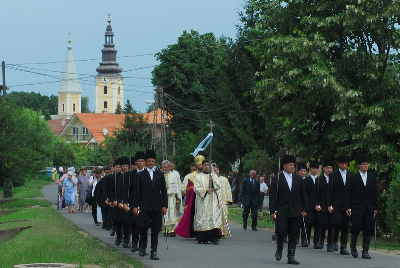
©
У місті Хайдудорог, розташованому на сході Угорщини, щороку на Великдень відтворюють давню церковну традицію, яку століттями передає з покоління в покоління місцева греко-католицька громада. Йдеться про ритуал почесної варти молодих чоловіків біля символічної гробниці Ісуса — вони відомі як «Воїни Христа». Початок традиції сягає часів Австро-Угорської імперії, однак її витоки — у Євангелії: згідно з текстом, після розп’яття Ісуса єврейські первосвященники поставили сторожу біля гробниці, аби запобігти викраденню тіла. У Хайдудорозі цей біблійний сюжет переплівся з місцевим звичаєм — виставляти озброєну почесну варту на похоронах представників гайдуської шляхти. Учасники — неодружені юнаки з міста — вдягаються у традиційні строї: чорні штани та піджаки, чоботи, капелюхи у стилі Бочкаї та мечі. Зелена туя на формі символізує скорботу, а після Воскресіння її замінюють на білі хустинки — знак радості. У ніч на Великдень воїни входять до храму строєм, ритмічно цокаючи чобітьми по мармуровій підлозі. Після опівнічної літургії вони синхронно стають навколішки, знімають капелюхи і схрещують мечі перед гробницею. Завершується обряд благословенням великодньої паски, коли двоє вартових супроводжують священника до церкви. У 2016 році традиція була офіційно внесена до Національного переліку нематеріальної культурної спадщини Угорщини. А ще раніше, у 2012-му, парламент Угорщини надав Хайдудорогу почесне звання «Міста, найвірнішого грецькій католицькій вірі».
Armed Easter watch in Hungary's Hajdudoróg preserves a unique tradition
In the town of Hajdúdorog, located in eastern Hungary, an ancient church tradition is revived each Easter by the local Greek Catholic community, who have preserved and passed it down through generations for centuries. This tradition involves an honor guard of young men standing vigil at a symbolic tomb of Jesus — they are known as “Christ’s Soldiers.” The custom dates back to the Austro-Hungarian Empire, though its roots lie in the Gospel: according to the Scriptures, after Jesus’ crucifixion, Jewish high priests placed guards at His tomb to prevent the body from being taken. In Hajdúdorog, this biblical account merged with a local noble tradition of posting armed guards at the funerals of members of the Hajdú aristocracy. The participants — unmarried young men from the town — wear traditional attire: black trousers and jackets, high boots, Bocskai-style hats, and carry swords. Green thuja branches on their uniforms symbolize mourning; after the Resurrection, these are replaced with white handkerchiefs as a sign of joy. On Holy Saturday night, the soldiers march into the church in formation, their boots echoing rhythmically on the marble floor. After the midnight liturgy, they kneel in unison, remove their hats, and cross their swords in front of the tomb. The ritual concludes with the blessing of the Easter bread (pászka), as two of the guards accompany the priest back to the church. In 2016, the tradition was officially added to Hungary’s National Inventory of Intangible Cultural Heritage. Even earlier, in 2012, the Hungarian Parliament granted Hajdúdorog the honorary title of “The Town Most Loyal to the Greek Catholic Faith.”
847